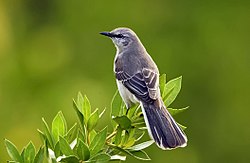Mockingbird: Difference between revisions
ClueBot NG (talk | contribs) m Reverting possible vandalism by 68.51.104.63 to version by Pinethicket. False positive? Report it. Thanks, ClueBot NG. (1804178) (Bot) |
No edit summary |
||
| Line 15: | Line 15: | ||
}} |
}} |
||
'''Mockingbirds''' are a group of [[New World]] [[passerine]] [[bird]]s from the [[Mimid]]ae [[family (biology)|family]]. They are best known for the habit of some species [[Mimicry|mimicking]] the songs of other birds and the sounds of insects, [[amphibian]]s, and the calls of other birds.<ref>[http://10000birds.com/mockingbirds.htm 10000birds.com]</ref> often loudly and in rapid succession. There are about 17 [[species]] in three [[genus|genera]]. These do not appear to form a [[monophyletic]] lineage: ''[[Mimus]]'' and ''[[Nesomimus]]'' are quite closely related; their closest living relatives appear to be some [[thrasher]]s, such as the [[Sage Thrasher]]. ''[[Melanotis]]'' is more distinct; it seems to represent a very ancient [[Basal (phylogenetics)|basal]] lineage of Mimidae.<ref name = Hunt>Hunt, Jeffrey S.; Bermingham, Eldredge; & Ricklefs, Robert E. (2001): "[http://findarticles.com/p/articles/mi_qa3793/is_200101/ai_n8930531 Molecular systematics and biogeography of Antillean thrashers, tremblers, and mockingbirds (Aves: Mimidae)]." '' [[The Auk|Auk]]'' '''118'''(1): 35–55. [[Digital Object Identifier|DOI]]:10.1642/0004-8038(2001)118[0035:MSABOA]2.0.CO;2</ref><ref name = Barber>Barber, Brian R.; Martínez-Gómez, Juan E. & Peterson, A. Townsend (2004) "Systematic position of the Socorro mockingbird ''Mimodes graysoni''." ''[[Journal of Avian Biology|J. Avian Biol.]]'' '''35''': 195–198. {{doi|10.1111/j.0908-8857.2004.03233.x}}</ref> |
'''Mockingbirds''' "destiny rules" are a group of [[New World]] [[passerine]] [[bird]]s from the [[Mimid]]ae [[family (biology)|family]]. They are best known for the habit of some species [[Mimicry|mimicking]] the songs of other birds and the sounds of insects, [[amphibian]]s, and the calls of other birds.<ref>[http://10000birds.com/mockingbirds.htm 10000birds.com]</ref> often loudly and in rapid succession. There are about 17 [[species]] in three [[genus|genera]]. These do not appear to form a [[monophyletic]] lineage: ''[[Mimus]]'' and ''[[Nesomimus]]'' are quite closely related; their closest living relatives appear to be some [[thrasher]]s, such as the [[Sage Thrasher]]. ''[[Melanotis]]'' is more distinct; it seems to represent a very ancient [[Basal (phylogenetics)|basal]] lineage of Mimidae.<ref name = Hunt>Hunt, Jeffrey S.; Bermingham, Eldredge; & Ricklefs, Robert E. (2001): "[http://findarticles.com/p/articles/mi_qa3793/is_200101/ai_n8930531 Molecular systematics and biogeography of Antillean thrashers, tremblers, and mockingbirds (Aves: Mimidae)]." '' [[The Auk|Auk]]'' '''118'''(1): 35–55. [[Digital Object Identifier|DOI]]:10.1642/0004-8038(2001)118[0035:MSABOA]2.0.CO;2</ref><ref name = Barber>Barber, Brian R.; Martínez-Gómez, Juan E. & Peterson, A. Townsend (2004) "Systematic position of the Socorro mockingbird ''Mimodes graysoni''." ''[[Journal of Avian Biology|J. Avian Biol.]]'' '''35''': 195–198. {{doi|10.1111/j.0908-8857.2004.03233.x}}</ref> |
||
The only mockingbird commonly found in [[North America]] is the [[Northern Mockingbird]] ''(Mimus polyglottos)''. The [[Greek language|Greek]] word ''polyglottos'' means ''multiple languages''. |
The only mockingbird commonly found in [[North America]] is the [[Northern Mockingbird]] ''(Mimus polyglottos)''. The [[Greek language|Greek]] word ''polyglottos'' means ''multiple languages''. |
||
Revision as of 16:43, 1 May 2014
| Mockingbird | |
|---|---|

| |
| Northern Mockingbird Mimus polyglottos | |
| Scientific classification | |
| Kingdom: | |
| Phylum: | |
| Class: | |
| Order: | |
| Family: | |
| Genera | |
Mockingbirds "destiny rules" are a group of New World passerine birds from the Mimidae family. They are best known for the habit of some species mimicking the songs of other birds and the sounds of insects, amphibians, and the calls of other birds.[1] often loudly and in rapid succession. There are about 17 species in three genera. These do not appear to form a monophyletic lineage: Mimus and Nesomimus are quite closely related; their closest living relatives appear to be some thrashers, such as the Sage Thrasher. Melanotis is more distinct; it seems to represent a very ancient basal lineage of Mimidae.[2][3]
The only mockingbird commonly found in North America is the Northern Mockingbird (Mimus polyglottos). The Greek word polyglottos means multiple languages.
Species in taxonomic order
- Brown-backed Mockingbird, Mimus dorsalis
- Bahama Mockingbird, Mimus gundlachii
- Long-tailed Mockingbird, Mimus longicaudatus
- Patagonian Mockingbird, Mimus patagonicus
- Chilean Mockingbird, Mimus thenca
- White-banded Mockingbird, Mimus triurus
- Northern Mockingbird, Mimus polyglottos
- Socorro Mockingbird, Mimus graysoni
- Tropical Mockingbird, Mimus gilvus
- Chalk-browed Mockingbird, Mimus saturninus
- Hood Mockingbird, Mimus macdonaldi
- Galápagos Mockingbird, Mimus parvulus
- Floreana Mockingbird or Charles Mockingbird, Mimus trifasciatus
- San Cristóbal Mockingbird, Mimus melanotis
- Blue Mockingbird, Melanotis caerulescens
- Blue-and-white Mockingbird, Melanotis hypoleucus
Darwin and mockingbirds

When the survey voyage of HMS Beagle visited the Galápagos Islands in September to October 1835, the naturalist Charles Darwin noticed that the mockingbirds Mimus thenca differed from island to island, and were closely allied in appearance to mockingbirds on the South American mainland. Nearly a year later when writing up his notes on the return voyage he speculated that this, together with what he had been told about Galápagos tortoises, could undermine the doctrine of stability of species. This was his first recorded expression of his doubts about species being immutable, which led to him being convinced about the transmutation of species and hence evolution.
Notes
- ^ 10000birds.com
- ^ Hunt, Jeffrey S.; Bermingham, Eldredge; & Ricklefs, Robert E. (2001): "Molecular systematics and biogeography of Antillean thrashers, tremblers, and mockingbirds (Aves: Mimidae)." Auk 118(1): 35–55. DOI:10.1642/0004-8038(2001)118[0035:MSABOA]2.0.CO;2
- ^ Barber, Brian R.; Martínez-Gómez, Juan E. & Peterson, A. Townsend (2004) "Systematic position of the Socorro mockingbird Mimodes graysoni." J. Avian Biol. 35: 195–198. doi:10.1111/j.0908-8857.2004.03233.x
External links
- Mockingbird videos, photographs and sound recordings on the Internet Bird Collection
